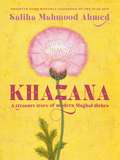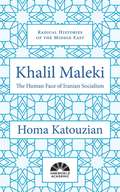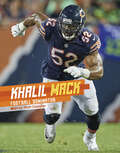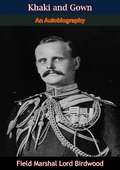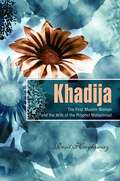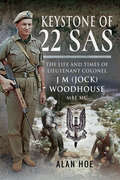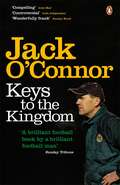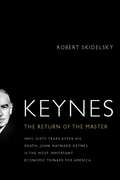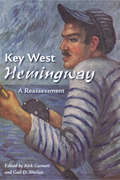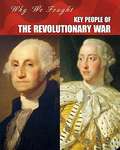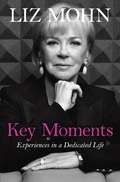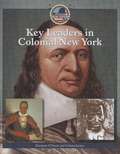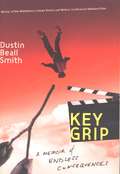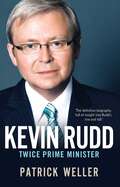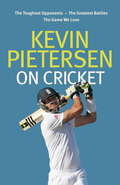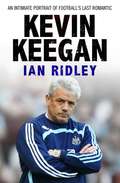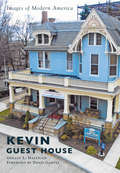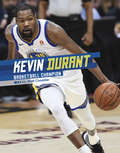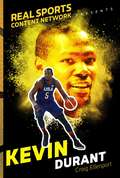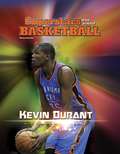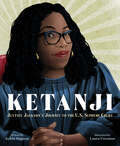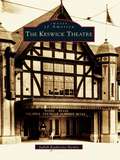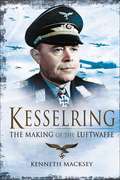- Table View
- List View
Khazana: An Indo-Persian cookbook with recipes inspired by the Mughals
by Saliha Mahmood AhmedOBSERVER FOOD MONTHLY COOKBOOK OF THE YEAR 2019Shortlisted for 'Travel Cookery Book of the Year' in the 2019 Edward Stanford Travel Writing Awards.'Delving into this book feels like taking a leap back into an exotic, saffron-scented past - with her beautiful writing and delicious recipes, Saliha takes you on a culinary journey of discovery.' - Thomasina MiersSaliha, who won over the MasterChef judges with her fusion of Indo-Persian food, has written a book that will delight. Drawing on the rich culinary heritage of the region and her own travels in modern-day India and Pakistan, the recipes are bang up-to-date and will inspire 21st century food lovers.Steeped in Persian flavours, Khazana, which means treasure trove, is a cookbook that promises to become a much-loved classic, introducing recipes like Smoked Chicken & Basil Kebabs with Beetroot Basil Salad & Beetroot Buttermilk Raita, Mughul Baked Cod Korma and Crème Fraîche & Rose Ice Cream with Honey-glazed Figs.'This debut cookbook from the 2017 MasterChef winner is inspired by the opulent Mughal empire and her travels across India. The perfect blend of Indian and Persian flavours, curries, rice, and beautiful samosas are lifted with rosewater, saffron, almonds and pomegranate' - BBC Good Food Magazine'A glittering hoard of Indo-Persian dishes' - Aldo Zilli, Express S Magazine
Khalil Maleki: The Human Face of Iranian Socialism (Radical Histories of the Middle East)
by Homa KatouzianKhalil Maleki (1901–1969) was a selfless campaigner for democracy and social welfare in twentieth-century Iran. His was a unique approach to politics, prioritising the criticism of policies detrimental to his country&’s development over the pursuit of power itself. An influential figure, he was at the centre of such formative events as the split of the communist Tudeh party, and the 1953 coup and its aftermath. In an age of intolerance and uncompromising confrontation, Maleki remained an indefatigable advocate for open discussion and peaceful reform – a stance that saw him jailed several times. This work makes a compelling case for him to be regarded among the foremost thinkers of his generation.
Khalil Mack: Football Dominator (Stars of Sports)
by Matt ChandlerAs a kid Khalil Mack loved basketball, not football. He didn't even start playing football until his senior year of high school. That season he racked up 140 tackles, an amazing total. From then on, football became Mack's focus, and he proved to be a force on the gridiron. In the National Football League, he was named defensive player of the year in 2016, and today he is widely recognized as one of the most dominant players in the pro game. It's easy to see why in this engaging, hard-hitting biography.
Khaki and Gown: An Autobiography
by Field Marshal Lord BirdwoodField Marshal William Riddell Birdwood, 1st Baron Birdwood, was a British Army officer. He saw active service in the Second Boer War on the staff of Lord Kitchener and action again in the First World War as Commander of the Australian and New Zealand Army Corps during the Gallipoli Campaign in 1915, leading the landings on the peninsula and then the evacuation later in the year, before becoming commander-in-chief of the Fifth Army on the Western Front during the closing stages of the war. An autobiography by an old soldier with tales of adventure from all over the world. The “gown” refers to his later years as Master of Peterhouse at Cambridge. Winston Churchill served with Lord Birdwood in the Boer War, and writes a glowing two-page foreword.
Khadija
by Resit HaylamazThe first Muslim and the wife of Prophet Muhammad Exploring the early days of Islam, this biography focuses on one of the most prominent and respected Muslim women in history, Khadija, the wife of the Prophet Muhammad. Addressing both her devotion and her leadership roles in Mecca, this book shines a light on a figure who is an inspiration to women, both Muslim and non-Muslim alike.
Keystone of 22 SAS: The Life and Times of Lieutenant Colonel J. M. (Jock) Woodhouse MBE MC
by Alan HoeThis British military biography tells the full story of the Lieutenant Colonel who helped turn the 22nd SAS into the world&’s leading special forces unit. Despite its successes during World War II, the future of the British Army&’s Special Air Service was uncertain for years afterward. In the 1950s, it was resurrected as the 22nd SAS Regiment to take part in the Malayan Emergency, and over time evolved into one of the British military&’s most important units. This renaissance was brought about by a small group of highly motivated officers. Of these, Lieutenant Colonel John Woodhouse stood out for his energy, expertise, and courage. Written by an SAS insider, this biography demonstrates how Woodhouse played a pivotal role in transforming the 22nd SAS into an elite fighting force. Woodhouse led the regiment through campaigns in Oman, Borneo, Radfan and South Arabia, as it built its unrivaled reputation. After leaving the Army, Woodhouse became a sought-after counter-terrorist consultant taking an advisory and active role in operations worldwide. While Colonel Sir David Stirling publicly acknowledged Woodhouse as a cofounder of the 22nd SAS, the full story of his role has not been widely recognized. As this fascinating book reveals, without his efforts there would probably be no 22nd SAS today.
Keys to the Kingdom
by Jack O'ConnorWhen Jack O'Connor took over as Kerry football manager in 2004, he was a relative unknown. Three All-Ireland finals, and two titles, later, he stepped down, having established himself as one of the greats. Keys to the Kingdom is his vivid account of those three seasons in the most high-pressure job in Irish sport.
Keynes
by Robert SkidelskyThe ideas of John Maynard Keynes have never been more timely. No one has bettered Keynes's description of the psychology of investors during a financial crisis: OCyThe practice of calmness and immobility, of certainty and security, suddenly breaks down. New fears and hopes will, without warning, take charge of human conductOC the market will be subject to waves of optimistic and pessimistic sentiment. ' Keynes's preeminent biographer, Robert Skidelsky, Emeritus Professor of Political Economy at the University of Warwick, brilliantly synthesizes from Keynes's career and life the aspects of his thinking that apply most directly to the world we currently live in. In so doing, Skidelsky shows that Keynes's mixture of pragmatism and realism OCo which distinguished his thinking from the neo-classical or Chicago school of economics that has been the dominant influence since the Thatcher-Reagan era and which made possible the raw market capitalism that created the current global financial crisis OCo is more pertinent and applicable than ever. Crucially Keynes offers nervous capitalists OCo and Keynes never wavered in his belief in the capitalist system OCo a positive answer to the question we now face: When unbridled capitalism falters, is there an alternative? In the long run, as Keynes famously said, we are all dead. We may not have time to wait for the perfect theoretical operation of capital as the neo-classicists insist will happen eventually. In the meantime, we have Keynes: more supple, more human and more magnificently real than ever.
Key West Hemingway: A Reassessment
by Kirk Curnutt Gail D. Sinclair"No other work has focused so sharply and revealed so clearly the vitality of Hemingway's time in Key West. Key West Hemingway shows that even as his Papa persona grew during the 1930s, Hemingway continued to generate a significant body of nuanced and complex (if also misunderstood) experimental prose. With keen scrutiny and brilliance, these fresh and readable essays rediscover and give us Hemingway's multifaceted American literary voices."--Linda Patterson Miller, editor of Letters from the Lost Generation "This impressive and cohesive collection of essays on Hemingway's Key West works and days puts into proper critical and biographical perspective one of the least understood yet most productive periods in his life. Husband, lover, father, son, fisherman, political activist, defender of the vets, essayist, and crafter of fiction--it's all here, close-up and wide-angle, the American Hemingway of 1928-1940, in all his facets, the rough diamond in the Florida sun."--Allen Josephs, author of Ritual and Sacrifice in the Corrida Conventional wisdom holds that Hemingway's Key West years were among his least productive, and many are dismissive of the works he produced during that time. In this collection, several leading Hemingway scholars focus on his overlooked short stories and essays, especially those written for Esquire from 1933 to 1936. They demonstrate how the island inspired some of his most vivid work and discuss how the "Hemingway industry" continues to endure. Kirk Curnutt is professor and chair of English at Troy University. Gail D. Sinclair is scholar in residence and executive director of the Winter Park Institute at Rollins College. Contributors: Patrick Hemingway | Carol Hemingway | Lawrence R. Broer | Gail D. Sinclair | Milton A. Cohen | Dan Monroe | Susan F. Beegel | Steve Paul | Mark P. Ott | Susan J. Wolfe | Mimi Reisel Gladstein | Michael J. Crowley | John J. Fenstermaker | E. Stone Shiftlet | Kirk Curnutt | James H. Meredith | Nicole Camastra | Russ Pottle
Key People Of The Revolutionary War (Why We Fought: The Revolutionary War)
by Patrick Catel Megan CotugnoThis book looks at key people of the Revolutionary War: George Washington, King George III, Benedict Arnold, and more.
Key Moments: Experiences in a Dedicated Life
by Liz Mohn"You always saw the world as your workplace."In 2009, this was how Reinhard Mohn--the man who turned Bertelsmann AG from an unremarkable, postwar German business into a successful, international media conglomerate--described the professional dedication of his wife, Liz Mohn. Born into a seemingly hopeless world, this girl from Wiedenbrück, Germany, grew into a proactive woman who, following her late husband's death, now represents the fifth generation of Bertelsmann's ownership. She sits on the company's supervisory board, where for decades she has brought unconventional ideas to a traditional media empire, and she also serves as vice chairwoman of the Bertelsmann Foundation's executive board. In her new book, Key Moments, Mohn tells her remarkable personal history, recalling with great candor the difficult early years in Gütersloh and how she grew into her role at the side of her influential husband. She met challenges with curiosity and a desire to learn from her mistakes. Through it all, she followed her life's motto: Try it. You can do it. An active philanthropist, Mohn highlights the importance of every individual being accountable to a greater good while appealing to the social responsibility of the political and economic sectors as well. She makes the case that each of us is called to contribute his or her part toward creating a successful future. This, of course, is what Liz Mohn has done all of her life. In light of her efforts and successes, she is often asked, "How do you do it all?" Key Moments gives readers a fascinating insight into the answer.
Key Leaders in Colonial New York (Spotlight on New York)
by Colleen Adams Elizabeth O'GradyNew York would not be the state it is today without the many strong leaders of its past. This fascinating resource examines some of the most influential men and women in New York s early history, including Peter Minuit, Sybil Ludington, Peter Stuyvesant, Red Jacket, and George Clinton. Entertaining biographical information is woven into the narrative of New York history and is presented along with primary source documents and paintings supporting the contributions of these early luminaries.
Key Grip: A Memoir of Endless Consequences
by Dustin Beall SmithA key grip, Dustin Beall Smith explains in this award-winning debut memoir, is the person on a film set who supervises the rigging of lights, set wall construction, dolly shots, stunt preparation, and more. Smith worked in the film industry throughout the 1970s, '80s, and '90s. For him, "fame by association"-with iconic stars including Sly Stallone, Susan Sarandon, and Robert De Niro-was just one of the seductive drugs fueling his high-octane days on the set. The intertwined stories in Key Grip resurrect memories of how his father's impossibly ordered life became a goad for Smith's own reckless journey to manhood. Its trajectory includes a stint as a pioneering sport-parachuting instructor in the late 1950s-a young man's dream job that taught Smith how to hide sheer animal fear behind male bravado. Much later, as a committed writer and unredeemed seeker in his fifties, Smith lights out cross-country for what turns out to be a brave, existentially failed-and very funny-attempt at a Lakota vision quest. Beautifully told, reminiscent of both Robert Bly and Ian Frazier, Key Grip is a fascinating record of the fault lines of one man's life.DUSTIN BEALL SMITH's Key Grip won the 2007 Bakeless Prize for nonfiction, awarded by the Middlebury College Bread Loaf Writers' Conference and judged by Terry Tempest Williams. Smith has lived in New York City for over forty years and teaches writing at Gettysburg College.
Kevin Rudd: Twice Prime Minister
by Patrick WellerIt was a very different Kevin Rudd who returned to office in 2013. Kevin 07 was a fresh face and a new image: the convivial, Mandarin-speaking nerd who seemed so different from past leaders and who held so much potential. By 2013 Rudd retained some of his popularity but none of his novelty. The Opposition could say nothing derogatory about him that his colleagues had not already said. A series of policy grenades had to be defused. His second term was to be short, brutal and nasty. Yet, despite his defeat, Kevin Rudd was an unusual Labor leader and prime minister. Political scientist and biographer Patrick Weller spent several years observing and talking to Rudd and the people around him to explain how one person came to the job and sought to meet its demands. Weller takes us back to Rudd's boyhood in Nambour, son of a poor Queensland dairy farmer; to a member without a faction who led a bitterly factionalised party; to the only federal Labor leader to win a majority since Paul Keating in 1993; and to only the second prime minister since 1914 to be sworn in for a second time. This book has the advantage of interviews in 2008 and 2009 with ministers who were then supporters but who became diehard enemies. Weller also had the benefit of unique access to the Prime Minister's Office. His biography is a revealing account of the man who became prime minister - twice.
Kevin Pietersen on Cricket: The toughest opponents, the greatest battles, the game we love
by Kevin PietersenIn 2014, Kevin Pietersen's autobiography was one of the most talked about sporting media stories of the year, largely due to the shockwaves it sent through the cricketing establishment. Now, Kevin turns his focus to events on the pitch, offering his views on what it takes to be a successful cricketer in the modern age. This summer's Ashes series has demonstrated just how demanding and unpredictable the game has become, and Kevin is ideally - perhaps uniquely - placed to comment on those developments. In KEVIN PIETERSEN ON CRICKET we'll see exactly how today's player approaches batting, bowling, bowling, captaincy, preparation, and many other aspects of the game itself, through the prism of the author's own experience. We'll see what it's like to face a bowler like Mitchell Johnson at his menacing best, learn how cricketers cope with the challenges presented by foreign climates and conditions, and gain a fresh understanding of how players manage the psychological side of the game.
Kevin Pietersen on Cricket: The toughest opponents, the greatest battles, the game we love
by Kevin Pietersen MBEIn 2014, Kevin Pietersen's autobiography was one of the most talked about sporting media stories of the year, largely due to the shockwaves it sent through the cricketing establishment. Now, Kevin turns his focus to events on the pitch, offering his views on what it takes to be a successful cricketer in the modern age. This summer's Ashes series has demonstrated just how demanding and unpredictable the game has become, and Kevin is ideally - perhaps uniquely - placed to comment on those developments. In KEVIN PIETERSEN ON CRICKET we'll see exactly how today's player approaches batting, bowling, bowling, captaincy, preparation, and many other aspects of the game itself, through the prism of the author's own experience. We'll see what it's like to face a bowler like Mitchell Johnson at his menacing best, learn how cricketers cope with the challenges presented by foreign climates and conditions, and gain a fresh understanding of how players manage the psychological side of the game.
Kevin Keegan
by Ian RidleyOn 16 January 2008, just three months after declaring that he was unlikely to ever manage again, Kevin Keegan ended weeks of feverish speculation from press and football fans alike by announcing his decision to once more become the manager of Newcastle United F. C. -- it was, without doubt, the news story of the season. There can be few managers who have divided public opinion throughout their career as Keegan has. A legendary player, Keegan never intended to make the transition from pitch to dugout and defied his own and others expectations when he first took the managerial reins at St James' Park, in 1992. Keegan quickly became a hero in the North East -- first taking the club to the Premiership, and then narrowly missing out on winning it. It was in the heat of that now infamous duel with Alex Ferguson and his Manchester United side, though, that the cracks first began to show. For all his optimism and energy as a leader there were signs of tactical and psychological weakness in Keegan; frailties that would come to haunt him later in his career -- most evidently during his disastrous spell in charge of England. A revered sports journalist with unparalleled access to insider exclusives, Ian Ridley is the perfect man for the task of understanding what it is that makes Keegan tick. Training his brilliantly incisive and penetrating gaze on Keegan, Ridley offers an unprecedented insight into the mind of this most enigmatic of men.
Kevin Guest House (Images of Modern America)
by Gerald L. Halligan Denis GarveyWhile unknown to many living in western New York, the Kevin Guest House has served thousands of critically ill individuals and their families for over 40 years. Quietly nestled within the expanding Buffalo Niagara Medical Campus of Buffalo, New York, the demand for the facility continues to increase. The opening chapter is a testimony to the Speyser-Beer family, who originally owned the property. The second and third chapters memorialize the founders of the Kevin Guest House, the Garvey family of Sharon, Pennsylvania. The remaining chapters provide a virtual tour of the grounds and building expansions of 2016.
Kevin Durant: Basketball Champion (Stars of Sports)
by Matt ChandlerStanding over 6 feet tall while in middle school, Kevin Durant seemed destined for basketball greatness. He was heavily recruited after high school and never folded to the pressure. From NBA rookie of the year to the NBA finals MVP, Durant has proven himself time and time again. This fresh biography from the Stars of Sports series breaks down his extraordinary list of accomplishments.
Kevin Durant (Real Sports Content Network Presents)
by Real Sports NetworkLearn about NBA superstar Kevin Durant in this book in a nonfiction series about your favorite athletes&’ childhoods and what (or who) helped them become the stars they are today!He&’s 6&’ 9&” with a wingspan of 7&’ 5&”, and everyone knows him as KD. He&’s a two-time NBA champ, two-time Finals MVP, and four-time Scoring Champ. He&’s Kevin Durant, and the NBA has never seen a player quite like him before. However, as impressive as the stats may be, what&’s even more impressive is the journey that Kevin Durant took to come to the NBA. Born in a suburb of Washington, DC, Durant quickly discovered basketball as a way off of the dangerous streets and out of a life of laboring for little reward. But he also learned that if he wanted to make it as a professional, he would need to work—and work hard! Durant wasn&’t afraid to do that and by high school he had become one of the best prospects in the thriving DC basketball scene. After a year of college, KD made the leap to the pros and he&’s never looked back. Learn all about the childhood that put him on the path to success in this fascinating biography.
Kevin Durant
by Shaina IndovinoKevin Durant may be a young player, but he's already done amazing things in his NBA career. After joining the league in 2007, Kevin was chosen as Rookie of the Year. He led the league in scoring for three years in a row and has been chosen to play in the NBA All-Star Game four times. In 2012, he was chosen as the All-Star Game MVP, a huge honor for any player but even more incredible for a young player. Learn more about how Kevin became the NBA star fans know today. Find out about his childhood in Washington, D.C., and how he learned to love basketball. Discover what makes Kevin the success he is today!
Ketanji: Justice Jackson's Journey to the U.S. Supreme Court
by Kekla MagoonFrom two Coretta Scott King Honor winners comes this uplifting picture book biography about Ketanji Brown Jackson, who is making history as the first Black woman to serve as a Supreme Court Justice.Ketanji Brown Jackson is no stranger to overcoming obstacles. When a high school guidance counselor told her she should set her sights lower than Harvard, she decided to go to Harvard for college and law school.When she became a public defender and saw inequalities in the justice system, she used her legal skills to advocate for people who needed help, but couldn’t afford an attorney.Ketanji’s path to the Supreme Court was unique: She’s the only current Justice to have been a public defender and one of a few who went to public school. Her story is powerful and heartening, and it’s a lesson in overcoming adversity by being true to yourself.Margaret A. Edwards Award winner, Printz Honor winner, and National Book Award finalist Kekla Magoon and Coretta Scott King honoree Laura Freeman reunite to present a generation of readers with a new inspirational figure.
Keswick Theatre, The (Images of America)
by Judith Katherine HerbstThe Keswick Theatre, located just outside Philadelphia, opened in 1928 in an era when four thousand similar structures were in various stages of design and construction across the country. Vaudeville was in its final days and film was just being born. Designed by acclaimed architect Horace Trumbauer, the theater evolved into the area's premier movie house. When the theater was threatened with demolition in the early 1980s, the Glenside Landmarks Society was formed with the hopes of restoring the building to its former grandeur. Today, operating as a commercial venture, it is one of the most acclaimed concert halls in the Philadelphia area. The Keswick Theatre celebrates this historic landmark through vintage images and recognizes the dedicated community members who have kept its doors open.
Kesselring: The Making of the Luftwaffe (Greenhill Military Paperbacks Ser.)
by Kenneth MackseyIllustrated with maps and a center section of black and white photographs. Kesselring-commander, leader, administrator; the only senior German officer to start and finish the Second World War holding a high command appointment. There was scarcely a major campaign in which he was not at some time deeply involved: he flew in the forefront of the battle over Poland, Holland, Britain, Russia and the Western Desert and was shot down five times; as a field commander he defended Tunisia, Italy and, ultimately, Germany. But it is as much for his role in the formation and development of the Luftwaffe that Kesselring is remembered-his were many of the ideas, plans and insights about the part played by aircraft in the land battle. They were central to the careful, systematic reorganization and building up of the German military machine in the 1920s and 30s. This first complete biography presents the complex, fascinating personality of a man whose qualities of utter determination, charm and good humor, harnessed to outstanding training and experience, enabled him to cope with both victory and defeat and, finally, when placed on trial for his life, to face his judges with dignity, equanimity and a staunch defense.
